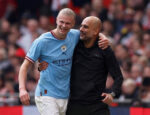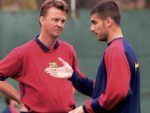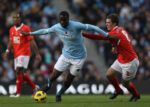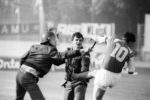Hasenhuttl has certain areas of the first team’s play that he wants to improve before the Premier League kicks-off again in August. Having arrived mid-season and in the midst of a relegation battle it was a case of Hasenhuttl having to adapt as he went along. But he wants to head into a new campaign with the squad fully up to speed with the style of play he wants to employ. Hasenhuttl wants to refine the different systems the team plays and ensure that they can change formation multiple times in any given match without significant disruption – Adam Leitch, Chief Sports Writer, Southampton Daily Echo.
In just the first five Premier League games this season, Southampton have lined up in three distinctly different shapes. Against Burnley, they started in a 5-2-3 shape, with three central defenders, two wing-backs, two central midfielders, and three forward players. Against Liverpool, the switch was made to a 5-3-2, with three central midfielders chosen alongside strikers Danny Ings and Che Adams. The Brighton and Manchester United games started off in a 4-2-2-2 shape, and against Sheffield United, the team reverted to the 5-2-3, with Sofiane Boufal and James Ward-Prowse flanking Adams, playing as a lone striker. The variance in starting formations, however, is just scratching the surface when it comes to Southampton’s tactical flexibility.
In the past two away wins for Southampton (a 2-0 against Brighton and a 1-0 against Sheffield United), we have seen a manager who is not afraid to change formations within a single match. I want to write a little bit about how those changes in shape have helped us win the games, and how the player who’s proved key to their ability to make these tactical adjustments, James Ward-Prowse, is quietly proving himself invaluable for Southampton.
In each of these games, we have seen a change in shape have a positive effect on the team, eventually leading to a winning goal being scored. I’ve done a bit of analysis of each game, especially the Djenepo goal against Brighton, as that’s the most obvious case of a formation change paying dividends. Watching the flexibility, experimentalism, and risk-taking that Hasenhuttl has employed is an absolute joy. He’s so good at keeping people guessing that even broadcasters are having trouble keeping up.
A rare right back/left winger substitution and Moussa Djenepo’s instant Brighton impact.
Against Brighton, Moussa Djenepo scored within two minutes of making his debut with a wonderful strike. What went rather unnoticed was that his introduction had come with a change in formation for the Saints, one Brighton hadn’t had time to adjust to by the time it was 1-0. Djenepo, a player who’s traditionally been a left-sided winger, came on for Yan Valery, a right back. It was certainly an eyebrow-raising substitution.
At the time, Southampton had been playing in a 4-2-2-2 shape, seen here with Kevin Danso debuting out of position as a left-back, and a front door including Che Adams and Danny Ings as strikers and Nathan Redmond and James Ward-Prowse in the attacking midfield “2”.
The Djenepo/Valery substitution coincided with a switch in formation, Hasenhuttl abandoned the 4-2-2-2 for a three at the back formation that’s best described as a 5-2-3 with extremely high wing-backs.
As Brighton was down a man, Southampton had reason to make an attacking-minded change, and that’s what happened here. Moussa Djenepo slotted in as a left wing-back, Kevin Danso shifted over towards playing as a left-sided central defender, and James Ward-Prowse moved to right wing-back. The double-pivot of Hojbjerg/Romeu stayed the same, and Redmond, Ings, and Adams functioned as a narrow attacking three, with Ings on the right and Redmond on the left. The shape itself can be seen fairly well (after the goal) here, where you can see both the back five in line as a single unit, and the other five outfielder players forming a box shape which allows them to press together as one unit.
As for the goal itself, it starts with Ward-Prowse clearing the ball after Ings lays it back to escape a four-person pressing box, as seen here.
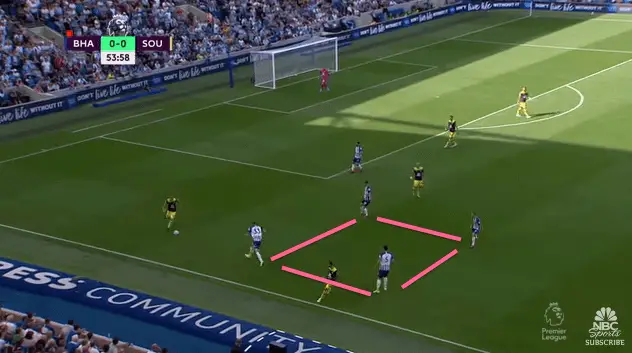
This ‘box’ includes Lewis Dunk and Dan Burn, who’s pressed extremely high up the pitch. Ings breaks forward from the right side, and wins the ball against Shane Duffy, the right-sided CB in the three.
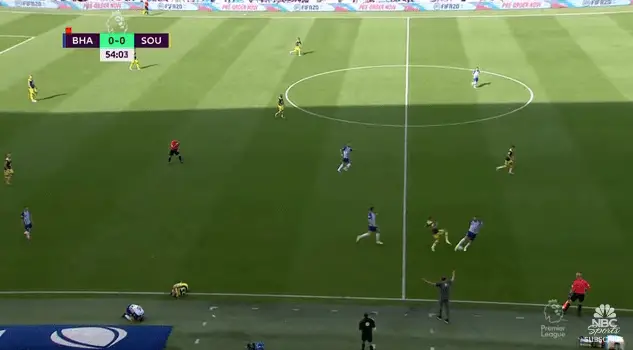
At the time Ings makes the pass,
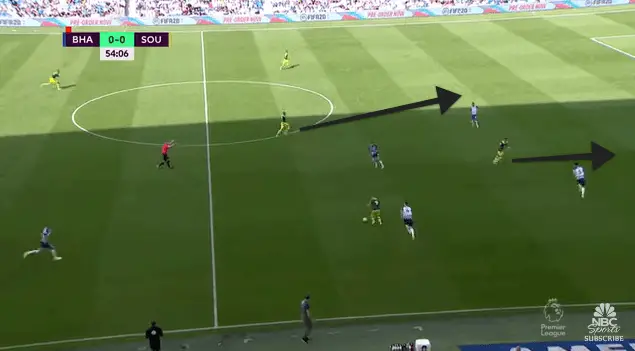
Che Adams is running into the channel between the two center backs involved in the play, occupying Dunk who’s had to make a long run just to get back involved in the play. Nathan Redmond (the left-sided attacking player for the whole game until now) is making a run forward to the left-most side of Brighton’s right wing-back, Martin Montoya . For the first 55 minutes of the game, those players were the basis of the attack, but the switch to a back five has added the threat of a true wide attacker in Djenepo, something Brighton haven’t had to really consider, particularly with Danso offering little going forward.
Before Djenepo takes the shot, Redmond makes a run behind Montoya, forcing him to decide which man to pick up immediately, which gives Djenepo the time and space to open up his body and shoot uncontested. It was a moment of great quality, and deserving of plaudits, but Ralph Hasenhuttl deserves credit as well for giving Brighton a new threat to deal with in a left wing-back who came on the pitch to play in an extremely advanced role.
vs. Sheffield United – Calculated risks & Changing positions without changing personell
Against Sheffield United, Hasenhuttl took a risk in starting Djenepo at that same left wing-back position, reverting to the 5-2-3 with Sofiane Boufal and James Ward-Prowse on either side of Che Adams. The idea behind it was to push him extremely high up the pitch, such as moments like these where when Saints have the ball, he’s nearly in line with the highest players up the pitch.
Nobody seemed to enjoy this decision more than George Baldock, who was able to exploit Djenepo’s poor positional sense and run into the space behind him over and over again. He consistently found himself isolated and vulnerable, or made errors with regards to his positioning here are some examples:
In the sixth minute
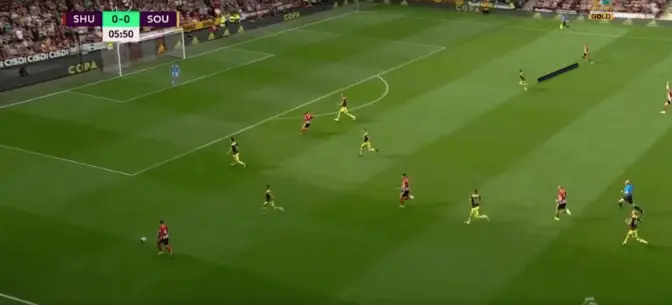
In the seventeenth minute, where he gets caught in a one-two and allows a ball to be crossed into Fleck for a decent chance
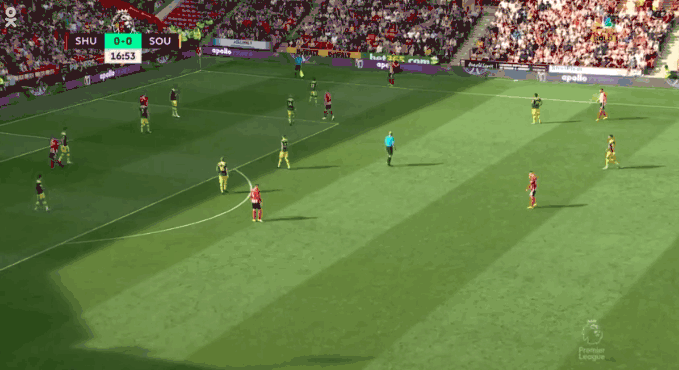
In the 20th minute, where he lets Baldock run freely in behind him
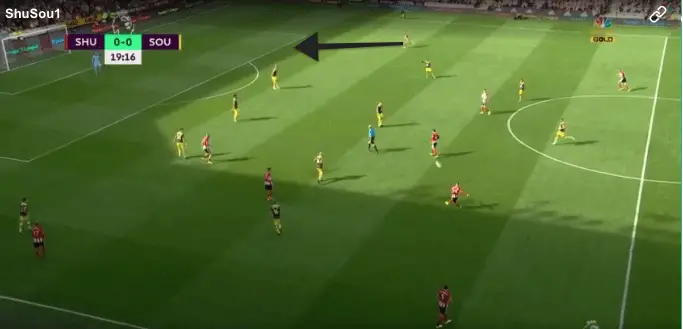
After about 35 minutes where Saints looked vulnerable down that flank, Hasenhuttl decided he’d seen enough, and moved some things around. Cedric Soares moved to the left wing-back position, Djenepo moved to the right wing, and once again, James Ward-Prowse moved to the right wing-back role. The adjusted formation can be seen clearly here, in a moment where Djenepo ends up being off screen as the furthest man forward; United continue to attack the left side of the Southampton defense, but Cedric, a natural fullback, is able to cut out the danger in this play
From then on, Southampton looked more defensively solid, and Djenepo found plenty of joy in the attacking phase of play, putting Boufal clean through on goal at the end of the first half before eventually winning the match with a brilliant solo goal.
Hasenhuttl addressed the decision, and the switch, after the match, saying:
“I tried to have a right footer on the left side to come inside and create and go into the red zone. Moussa showed against Liverpool in the last ten minutes that he can play this position [left wing-back] in an offensive way but it was sure a risk but I wanted to take this risk. When you have a few players who are flexible and you can change without taking a substitution then this is a team you can work with. Cedric went on the other side and Prowsey on the right and I knew before I could change this and if it doesn’t work we can do it like this.
While some Saints fans (myself included) weren’t too happy with the decision to play Djenepo as a wing-back, hearing a quote like this seems to have appeased a lot of the fanbase, as it indicates that he knowingly took a risk with the knowledge that should it not work out, he has the belief and the ability in his squad to change the players around and add defensive nous without needing to make a substitution.
The Key Cog In The Machine: James Ward-Prowse
The lynchpin for this flexibility is James Ward-Prowse, a player who’s having a season that’s very much flying under the radar, but who’s been instrumental to Southampton’s recent uptick in form.
“No more Mr. Nice Guy” is perhaps the best way to describe how the “academy golden boy” has transformed under Ralph Hasenhuttl. Often thought about in years previously as a tidy, technical player with great dead ball ability but perhaps lacking the physicality to deal with the rigors of the Premier League every week, Prowsey is proving week in and week out that it’s not the case anymore. It was mentioned in the United match that he’s covered the most distance of any player in the Premier League this season, and last year he went on a streak of 7 games where he covered the most distance of any player in the league on a particular match week.
Additionally, he’s shown proficiency anywhere along the right side of the pitch, whether that’s as a wing back, central midfielder, or attacking midfielder. He’s lacked the free kick goals that will steal the headlines, and hasn’t got off the mark in terms of goals or assists, but has played a key role in keeping two straight clean sheets from a wing back position, improving in a role which he’s been challenged to learn under Hasenhuttl.
Ironically, one of the biggest knocks against Ward-Prowse in years past which has prevented him from truly breaking out was that managers couldn’t seem to figure out his best position. Was he a central midfielder? a right midfielder? and attacking midfielder? It turns out that the answer is yes, and more, and instead of being an issue, his versatility is something that has led him to be a key man in Ralph Hasenhuttl’s Southampton. In the stretch of a year, he went from barely featuring in the team to being a player whose manager was openly admitting a bit of surprise that no top six teams were interested in him.
This post first appeared on r/soccer by TheRalphExpress


